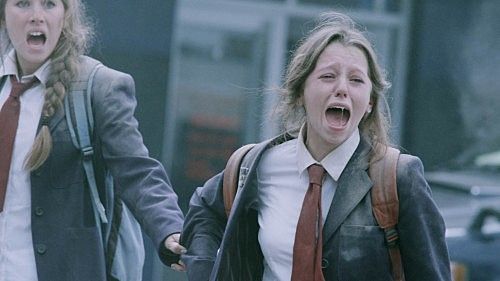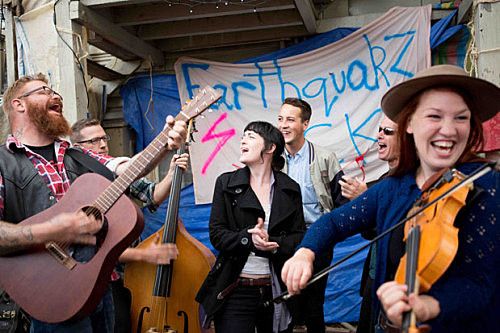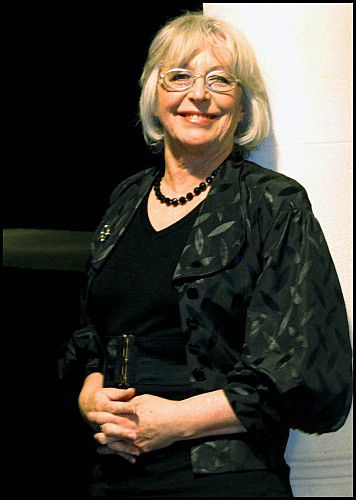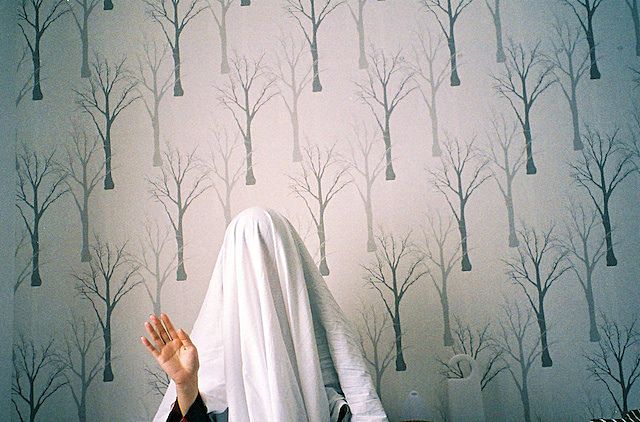A Town Like Here
Gaylene Preston’s Christchurch earthquake drama, Hope and Wire, debuted on TV3 this week. The series borrows the title of The Eastern’s 2012 album, which was recorded in quake-ruined Dallington. Preston and The Eastern’s Adam McGrath talk to Gavin Bertram about their chance meeting, and the other experiences that bought the show to fruition.
“I help them get into shape, give them a little context, feed and fuel ‘em up and let ‘em go. That’s my job.”
Adam McGrath wrote this explanation of his songs in a lengthy Facebook post during early June. The wry but heartfelt message from The Eastern’s frontman detailed how the title of the Lyttelton band’s third album, 2012’s Hope and Wire, had been adopted by Gaylene Preston’s latest work.
Hope and Wire the album was recorded in the aftermath of the quakes in Dallington, one of the worst hit north-east suburbs. Hope and Wire the television series starts from a similar origin point - a story about repercussions rather than disaster itself, the ordinary people living in the aftermath of the Christchurch earthquakes of September 2010 and February 2011. From the trailers leading up to Thursday’s debut on TV3, it looks like heart-rending viewing, but also like something of a wakeup call for many outside the city, who quickly moved on to “new” news.
An idea travels, Preston says. Following the catastrophic earthquake on February 22nd, 2011, people in Lyttelton began gathering on a corner in the ruined town centre and stitching small woollen hearts.
The ‘Lyttel Stitchers’ gave them to passers-by, as well as attaching them to the fences around the rubble. For Preston, this became an enduring image of hope amongst the chaos that resonated with The Eastern’s album title. They find their way into the foreground and background of Hope and Wire on numerous occasions, bound through frayed cable.
“I thought Hope and Wire is a wonderful title, because for me it articulated the iconic image of the heart on the fence,” she says. “I liked the idea of (it) growing from the shaky ground outside the Lyttleton Library, and becoming an album by a little band of travelling troubadours, and then becoming a television series.
As the project developed, the title Hope and Wire became the kaupapa, Preston says, a guiding influence that “kind of told us how to do it somehow”. Fittingly, she and McGrath first met when The Eastern were on the release tour for Hope and Wire in early 2012. The band were making an in-store appearance at a Wellington record shop, and the two were introduced.
McGrath was excited to meet the film-make,r who has been telling domestic but politically charged New Zealand stories for decades, including Bread and Roses, War Stories Our Mothers Never Told Us, Survivor Stories, and Home by Christmas.
“A couple of days later she took me out for a bowl of chips and a beer and we just started talking about all kinds of things,” McGrath says. “She asked me about the earthquake, and it was pretty heavy in a way, it got a bit emotional. We seemed to hit it off and it was nice to share things with her, and she told me things about her life.”
Preston began thinking about the project soon after the first Christchurch earthquake, on September 4, 2010.
Having grown up under the spectre of an earthquake, it was a subject close to home. Her first 10 years were spent in Greymouth, but Preston's family moved to Napier in the late 1950s. Over a quarter of a century after the huge 1931 Hawke's Bay earthquake, it still had a powerful hold over the city.
“Everything in Napier seemed to be 'because of the earthquake',” Preston remembers. “When I was at art school in Christchurch I would come back to Napier and work in a residential care place for the elderly and the stories would just flow about the earthquake. I was kind of in earthquake story city, in 1967.” She adds that while she was traumatised by the “nasty, jolty” earthquakes she experienced in Napier as a child, they were nothing like those suffered by Cantabrians.
Preston had been further inspired by a story from The Press about a couple living in the red zone for three months with no water or power, caring for stray animals. From her encounter with McGrath, she learnt how during the weeks after the February 22, 2011 earthquake The Eastern had offered another kind of public service, performing for free in people's gardens and in parks around the city. These simple acts are emblematic of the 'Hope' part of the television series' title.
“I needed to find a positive heart to tell a larger tale,” Preston says. “The heart of Hope and Wire is people feeding stray animals - looking after each other.”
“You become empowered when you are inspired by something, or inspired by others,” McGrath reflects. “During that period we were doing lots of stuff, and it was our way of trying to be of service. But we were given a lot of gifts around that - by seeing what people are actually capable of. We saw the way people can be good to each other and do amazing things. Those stories need to be shown, because it’s not just things on fire and cars in holes. It’s all kinds of other things and we have to concentrate on that. Otherwise you fall into despair and then all the bad stuff wins.”
After their initial meeting in Wellington, Preston visited Christchurch to gather stories for the nascent project. McGrath facilitated the process, picking her up at the airport, showing her around what remained of the city, and introducing her to people.
Preston says there was no difficulty in getting people to talk about their earthquake experiences – in fact, most had a need to speak about it. “With a big communal trauma, everybody's story is so unique and held differently,” she says. “It was a great experience. I would have gone down to Christchurch anyway, and I would have heard all those stories anyway, and it would have been quite frustrating for me to have not been able to make it into a shaped piece of audio/visual storytelling, because that's what I do. I can't help it.”
Having gathered a raft of stories over numerous visits to Christchurch, Preston began distilling those experiences into what would become Hope and Wire. At home in Wellington she had the assistance of playwright Dave Armstrong (The Tutor, Niu Sila, Spin Doctors, Seven Periods with Mr Gormsby).
It was, Preston says, an interesting writing experience, due to the complexities of needing to tell a universal story through specific characters. “It endeavours to tell a big story that is kind of everybody's story and nobody's story,” she explains. “I needed characters who could carry lots of stories within their story arc, and who were a great range of ages, and that could represent different geological parts of the city, and different demographical parts of the population.”
Claiming to be old-fashioned in her approach, Preston says she prefers cutting things out and putting them on boards rather than working electronically. As a consequence one part of her home “was basically knee deep in paper”, while another was dedicated to cutting news footage from the earthquakes that related to the emerging story.
The film-maker likens the process to making a big painting rather than sitting down and writing. Meanwhile, as the project evolved, The Eastern were touring and performing constantly, as they tend to do.
In time, Preston asked the band if they wanted to be a part of the series, and perhaps appear in it. McGrath says he was wary at first, but everything Preston said made sense, and he could see the value in the show.
And as it was going to happen anyway, he naturally wanted it to be as good as possible. Eventually Preston decided she wanted to call the series Hope and Wire. Although the song was not about the earthquakes, its themes of finding solidarity, and strength, in other people, were a perfect fit.
“I was flattered, but also thought ‘oh no, now we’re really hitched to it’,” McGrath says. “So we put a lot of trust in her, but I feel like it’s been rewarded. I’m proud that it’s got that title; you write songs and they have different jobs to do. I guess this song had other things that it needed to do, and now this whole thing is stuck to it for better or worse. If people find themselves not enjoying the show or not finding it truthful, I respect that and have to wear that because we’re tied to it.”
Scouting locations and filming in the restricted areas of Christchurch during 2013 had multiple dangers and difficulties. Preston says the project benefited greatly from the support of both the Christchurch City Council, and CERA. As she explains, making a film under normal conditions is always a nuisance for others, and in Christchurch they were dealing with people who had important work to do.
But many went out of their way to make Hope and Wire a reality – including finding tonnes of liquefaction silt that had been scientifically tested to make sure it wasn't toxic in order to recreate suburban Christchurch’s ravaged, marshy streets. Preston says no matter how difficult things were for those working on the series, they were standing alongside people who were living the realities of what was being depicted.
“We just had to go in there with a positive heart and listen very carefully to what was required from people, and to be a bit mindful,” she says. “That's actually not a bad thing for a film crew to learn how to do - mindfulness. It's not a bad thing for humans to do.”
Since the idea for Hope and Wire was made public, and particularly since it attracted over $5 million in funding from the NZ On Air Platinum Fund, it has divided opinion. Some have baulked at the level of funding, while some Cantabrians believe it is too soon – and always will be – to make a drama based around tragedy.
Preston is sensitive to the latter concern, but is understandably unrepentant on the funding issue. She believes that there are two industries in New Zealand film and television – one built on international money, the other on “inspired amateurism”. For decades this has seen many producers and directors essentially working for free.
“For the work that I do, you can't really do much in film without funding,” Preston says. “I think it's amazing what gets done under those circumstances, and Hope and Wire isn't actually any different. It's really low budget for what it's trying to achieve and for what it has managed to achieve. It's done it with a huge amount of support, not just from the industry but also from all the Christchurch people who came and helped us with the shoot.”
Having previously described Hope and Wire as “a postcard to Auckland”, Preston believes some in Christchurch should probably not watch it. She says the reaction to it being made is understandable, and based on the trauma and rage that is part of the grieving process. As she explains, Hope and Wire isn't about the tragedy of lives lost, or the heroes of the earthquakes - it's about the everyday struggles in the disaster's wake.
“I wanted to tell a story of common experience,” Preston says. “In the long run that's often what gets left out somehow, the normal daily grind of it, and the humour of it, and the challenge of it that isn't extreme. Hope and Wire is just down amongst the people who had to manage with no running water.”
Those involved hope that the outward focus – the intention for Hope And Wire to serve as a missive to comfortable, stable Auckland - will adequately communicate the realities dealt with by those living in post-quake Christchurch. For McGrath, one of the catalysts for being involved was a conversation about the quakes in a café wherein an Aucklander said “well, I don't see what what the big deal is”.
“I definitely know that there are people who don’t understand the magnitude of it and that it is continuing,” he says. “It’s inside everyone here. The show is important because it will let people know.”
Having also observed how off the radar the situation is in the North Island, Preston believes that's down to a feeling of helplessness, and hopes the series will help people outside Christchurch to engage without feeling guilty. She says it's been a privilege to make the series, and gives credit to everyone involved.
Hope and Wire:
Director: Gaylene Preston
Producers: Gaylene Preston and Chris Hampson
Associate producer: Sue Rogers
Writers: Gaylene Preston and Dave Armstrong
Cinematography: Thomas Burstyn
Second unit director: Alun Bollinger
Editing: Paul Sutorius, Jonathan Woodford-Roninson, Ange Boyd
Cast: Rachel House, Bernard Hill, Joel Tobeck, Anton Tennet, Chelsea Preston Crayford, Kip Chapman, Luanne Gordon, Stephen Lovatt, Jarod Rawiri, Miriama McDowell, Lucy Wyma, David Sutherland, Eilish Moran, Simo Abbari, Loren Taylor, Dame Kate Harcourt.




